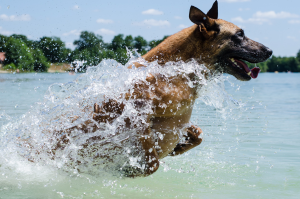“We’re set for a scorcher” – it’s a phrase that comes hand-in-hand with the Australian summer. With many places reaching above and beyond 40°C during our summer, many of our pets can suffer from the heat without us realising until, sometimes, it’s too late.
There are certain pets that may suffer from heatstroke more than others. These include pets with black or dark fur (which traps heat much more than fair fur), overweight pets, and certain breeds with “squashed faces” such as pugs, who cannot circulate air through their narrow nasal passages as well. In fact in 2017, Melbourne couple Jasminka Hewitt and partner David Loosz lost their French bulldog pair Hank and Dita to the effects of heatstroke after their dog sitter exercised them in extreme heat, emphasising just have destructive summer heat can be.
Heatstroke occurs when your pet’s body temperature-regulation mechanism fails due to exposure to excessively high temperatures. In pets, heatstroke can be determined in several ways including:
If you suspect that your pet is suffering from h eatstroke, they should be taken to your vet as soon as possible, as it can affect the organs and nerves and can damage your pet’s body even if experienced for just a short period of time. Keep them cool on the way to the vet with your car’s air conditioning and try and get them to drink water if they can. If your pet is suffering from less-severe heat distress, they can be treated at home – try lowering their body temperature gradually with a wet towel and by offering them cool (not chilled) water. Never leave your dog locked in a car on a hot day, and exercise caution even for pets left indoors.
eatstroke, they should be taken to your vet as soon as possible, as it can affect the organs and nerves and can damage your pet’s body even if experienced for just a short period of time. Keep them cool on the way to the vet with your car’s air conditioning and try and get them to drink water if they can. If your pet is suffering from less-severe heat distress, they can be treated at home – try lowering their body temperature gradually with a wet towel and by offering them cool (not chilled) water. Never leave your dog locked in a car on a hot day, and exercise caution even for pets left indoors.
Speaking of heatstroke, sun damage is more common in some pets than others. Due to the decreased pigment levels in their skin, pets with white or very light fur will suffer in the sun, as will dog breeds such as staffies, greyhounds and boxers. Pet-safe sunscreen can be applied to problem-prone areas including the ears, nose and belly, and you should exercise caution by keeping sun-sensitive pets in a shady, cool environment during the hottest and sunniest parts of the day.
Heatstroke can be avoided in pets by following some handy tips including:
And lastly, don’t forget to follow your instincts this summer: if you’re hot, your pet probably is too! With awareness and care, your pet will happily enjoy summer by your side.